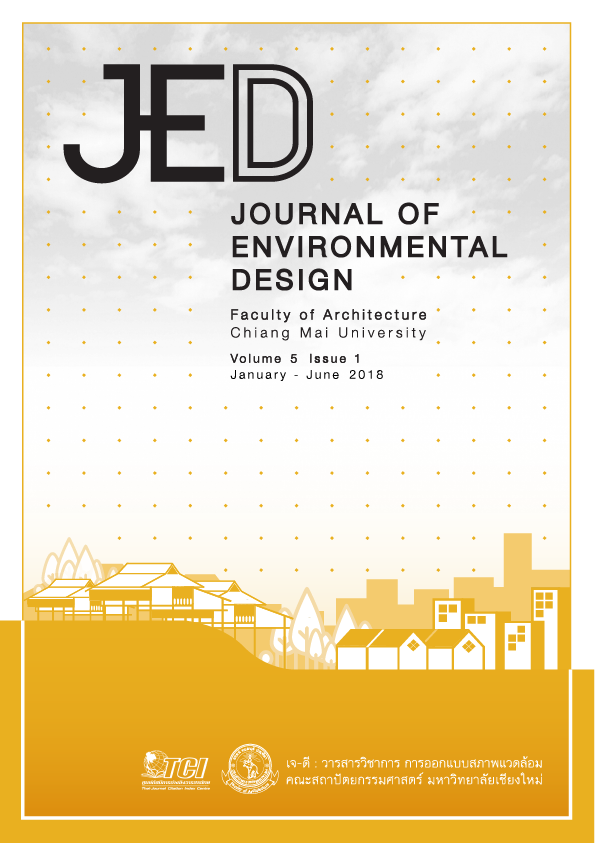ปัญหาและอุปสรรคการจัดการระบายน้ำฝนในบริบทเมืองที่มีการเติบโตทางกายภาพอย่างรวดเร็ว: กรณีศึกษาพื้นที่มหาวิทยาลัยเกษตรศาสตร์ วิทยาเขตบางเขน
Main Article Content
บทคัดย่อ
การเจริญเติบโตทางกายภาพของเมืองอย่างรวดเร็ว การขาดแคลนระบบระบายน้ำฝน ความด้อยประสิทธิภาพของการจัดการระบายน้ำฝนและป้องกันน้ำท่วม เป็นสาเหตุสำคัญที่ทำให้เกิดน้ำท่วมขังในเมืองหลังฝนตก บทความวิจัยชิ้นนี้มุ่งศึกษาปัญหาและอุปสรรคการจัดการระบายน้ำฝนและป้องกันน้ำท่วมขังในบริบทเมืองที่เป็นพื้นที่ลุ่มต่ำและมีการเติบโตทางกายภาพอย่างรวดเร็วว่ามีลักษณะอย่างไร โดยใช้พื้นที่ของมหาวิทยาลัยเกษตรศาสตร์ วิทยาเขตบางเขนเป็นกรณีศึกษา การวิจัยชิ้นนี้เป็นการวิจัยเชิงคุณภาพที่ใช้การผสมผสานระหว่างข้อมูลเชิงเอกสารและข้อมูลจากภาคสนามอันได้แก่ การสำรวจพื้นที่และการสัมภาษณ์แบบเจาะจงกับผู้เกี่ยวข้อง ผลการศึกษาพบว่าลักษณะการเกิดน้ำท่วมขังในวิทยาเขตหลังฝนตกขึ้นอยู่กับความสามารถของพื้นที่ในการหน่วงกักเก็บน้ำ และลักษณะของระบบระบายน้ำฝนออกจากพื้นที่ สาเหตุของการเกิดน้ำท่วมขังหลังฝนตกมาจากระบบระบายน้ำที่ไม่ต่อเนื่องและแหล่งน้ำธรรมชาติที่หายไปจากการเปลี่ยนแปลงการใช้ที่ดิน การเกิดพื้นที่ลุ่มต่ำเสี่ยงต่อการถูกน้ำท่วมขังเนื่องจากการเปลี่ยนแปลงพื้นที่เพื่อสร้างสิ่งปลูกสร้างหรือปรับปรุงภูมิทัศน์ใหม่ การเปลี่ยนแปลงพื้นที่ทางกายภาพที่ไม่สอดคล้องแนวทางผังแม่บท การลดลงของปริมาณพื้นผิวพรุนน้ำอย่างต่อเนื่อง และการขาดการบูรณาการระหว่างการวางแผนการใช้ที่ดินและการจัดการระบายน้ำฝน ข้อมูลเชิงประจักษ์จากผลการศึกษาสอดคล้องกับผลของงานวิจัยก่อนหน้าหลายชิ้นที่แสดงให้เห็นว่า ปัจจัยที่มีอิทธิพลต่อปัญหาของการจัดการน้ำฝนและการป้องกันน้ำท่วมขังในเขตเมือง มิใช่เพียงประสิทธิภาพระบบการระบายน้ำเชิงวิศวกรรมเท่านั้นแต่ยังรวมถึงนโยบายและแนวทางการใช้ที่ดิน มหาวิทยาลัยควรพัฒนาข้อมูลพื้นฐานเชิงกายภาพของผังการใช้ที่ดินและสิ่งปลูกสร้างให้เป็นปัจจุบันเพื่อส่งเสริมการตัดสินใจที่มีประสิทธิภาพ ตลอดจนสร้างความตระหนักรู้ร่วมกันแก่สาธารณะของความสำคัญในการสงวนรักษาพื้นที่เปิดโล่งพรุนน้ำ ควรมีการจัดรูปองค์กรที่ส่งเสริมให้เกิดกลไกการสื่อสารระหว่างคณะกรรมการพัฒนากายภาพ หน่วยงานวางผังแม่บทและกองยานพาหนะและอาคารสถานที่ เปิดโอกาสให้ข้อมูลไหลเวียนย้อนไปและกลับเพื่อปรับปรุงการดำเนินการระหว่างแผนและการปฏิบัติ เพื่อให้ได้แนวทางการจัดการสภาพแวดล้อมทางกายภาพของวิทยาเขตบางเขนที่ตอบสนองการเปลี่ยนแปลง และลดความเสี่ยงจากการเกิดน้ำท่วมขังหลังฝนตกได้ในระยะยาว
Article Details
เอกสารอ้างอิง
Brown, R. R. (2005). Impediments to integrated urban stormwater management: the need for institutional reform, Environmental Management, 36 (3), 455-468 doi: https://doi.org/10.1007/s00267-004-0217-4.
Davivongs, V., Tangkitngamwong, O., & Naka, P. (2016). Karn pattana phuentee si khiao boriven Mahawitthayalai Kasetsart Bangkhen phuea mung su kan pen mahawitthayalai si khiao. (in Thai) [Aiming for green university: the study of green area in Kasetsart University, Bangkhen Campus]. Research report. Bangkok: Faculty of Architecture, Kasetsart University.
Grigg, N. S. (2011). Governance and management for sustainable water systems. London: IWA publishing.
Jha, A. K., Bloch, R., & Lamond, J. (2012). Cities and flooding: a guide to integrated urban flood risk management for the 21st century. Washington D.C.: The World Bank, GFDRR.
Limthongsakul, S. (2011a). Karn prayuk chai naewtang karn borihan chatkan nam phiodin duai naewkid LID phainai Mahawitthayalai Kasetsart Witthayaket Bangkhen. (in Thai) [Utilizing LID concepts for stormwater management in Kasetsart University, Bangkhen Campus]. Academic Journal of Architecture, Chulalongkorn University, 60 (1), 85-98.
Limthongsakul, S. (2011b). Krongkarn sueksa lae pramoen rabob rabai nam phio din phainai Mahavittayalai Kasetsart Wittayaket Bangkhen tam naew tang LID. (in Thai) [KU’s spatial assessment for sustainable development: landscape and architectural approach]. Research report. Bangkok: Faculty of Architecture, Kasetsart University.
Limthongsakul, S., Nitivattananon, V., & Arifwidodo, S. D. (2017). Localized flooding and autonomous adaptation in peri-urban Bangkok. Environment and Urbanization, 29 (1), 51–68. doi:10.1177/0956247816683854.
Parkinson, J. (2003). Drainage and stormwater management strategies for low-income urban communities. Environment and Urbanization, 15 (2), 115-126. doi: 10.1177/095624780301500203.
Parkinson, J., & Mark, O. (2005). Urban stormwater management in developing countries. London: IWA Publishing.
Pastore, M. C. (2015). Reworking the relation between sanitation and the city in Dar es Salaam, Tanzania. Environment and Urbanization, 27 (2), 473–488. doi: 10.1177/0956247815592285.
Ratanawaraha, A. (2016). Institutional issues in integrating land use planning and water management in Thailand. Bangkok: Thailand development research institute.
Saito, N. (2014). Challenges for adapting Bangkok’s flood management systems to climate change. Urban Climate, 9 (1), 89–100. doi: https://doi.org/10.1016/j.uclim.2014.07.006.
Sunakorn, et al. (2002) Rai ngan phon krathob tang dan kaiyaparb an nueang ma jak karn tueb tho khong Ongkon: koranee sueksa Mahawitthayalai Kasetsart Witthayaket Bangkhen. (in Thai) [The impacts of physical growth from the institutional growth: a case study of Kasetsart University, Bangkhen Campus]. Bangkok: Faculty of Architecture, Kasetsart University.
Sunakorn, et al. (2016). Khrongkan sueksa phuea jad tham phaen mae bot witthayaket si khiao Mahawitthayalai Kasetsart Bangkhen (in Thai) [The study for new master plan for green campus Kasetsart University, Bangkhen]. Bangkok: Faculty of Architecture, Kasetsart University.
Wheater, H., & Evans, E. (2009). Land use, water management and future flood risk. Land Use Policy, 26 (1), S251–S264. doi:10.1016/j.landusepol.2009.08.019.


